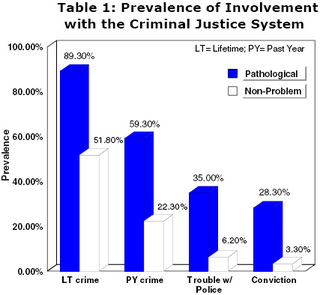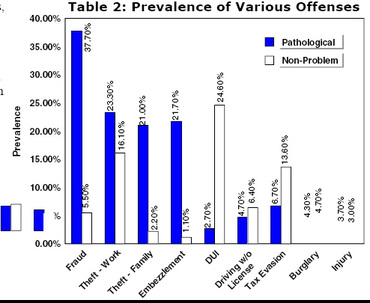Regular WAGER readers know that many a journal article has been devoted to the relationship between gambling and criminal activity [e.g., WAGER 4(13)]. This discourse was furthered by recent work by German researchers Gerhard Meyer and Michael A. Stadler. Their study had two objectives: 1) Examining patterns of criminal behavior among pathological and non-pathological gamblers and 2) Building a model to
explain crime’s relationship to the addictions. This week’s WAGER will discuss the first goal; next week, the second goal will be addressed.
The authors assembled a sample of 300 pathological gamblers currently in treatment. Pathological gamblers
were identified using instruments prepared specifically for this study. This means that the construct measured may or may not be identical to a counterpart construct identified using an established instruments such as the SOGS or the DIS. The non-problem sample consisted of 274 high and low frequency gamblers taken from various gambling venues. All subjects were interviewed about criminal behavior and involvement with the criminal justice system. Tables 1 and 2 present these findings.
Although the authors do not provide information regarding the statistical significance of their findings,
Table 1 shows that pathological gamblers are more likely to have had involvement with the criminal
justice system. Table 2 illustrates that fraud, theft, and embezzlement are the offenses most commonly
committed by pathological gamblers. These findings seem to make sense; these crimes are associated with the immediate procurement of funds necessary to continue gambling. It is interesting to note that DUI (driving under the influence), driving without a license, and tax evasion were more prevalent among
the non-pathological sample. These offenses generally involve little or delayed monetary gain; perhaps this explains their unattractiveness to pathological gamblers.
Many previous studies have examined the differential crime rates between gamblers and non-gamblers. The present study, however, examines the differences between non-problem gamblers and pathological gamblers. Thus, this study allows us to consider the relationship between addiction and crime rather than gambling and crime. Next week, The WAGER will pursue this matter further.
References
Meyer, G. & Stadler, M.A. (1999). Criminal behavior associated with pathological gambling. Journal of
Gambling Studies, 15, 29-43.






